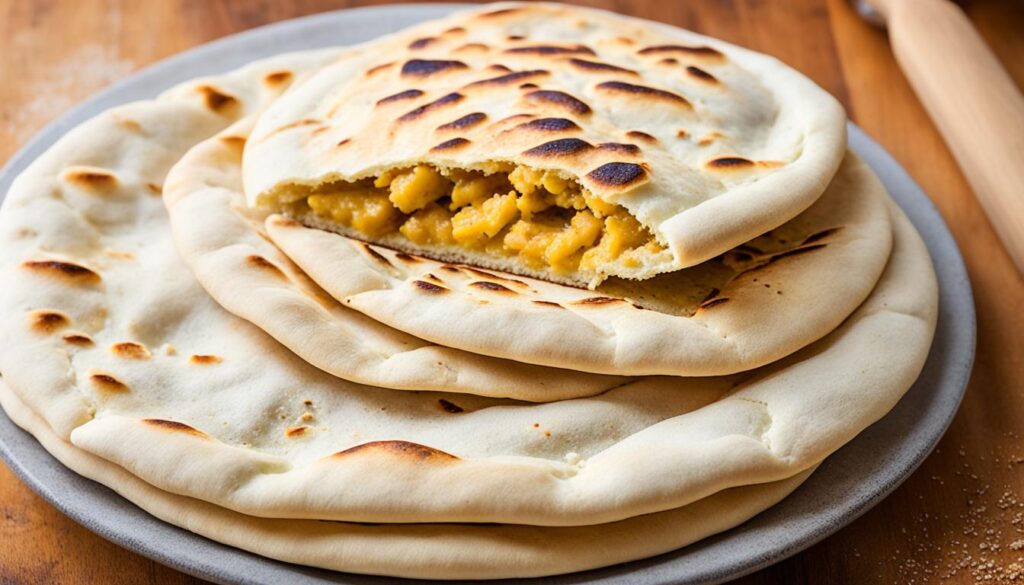If you’re a fan of Middle Eastern cuisine, chances are you’re familiar with Pita bread. This versatile and delicious bread is a staple in Middle Eastern cooking, and it’s not hard to see why. Pita bread can be used in a variety of dishes, from classic falafel and shawarma sandwiches to serving as a vessel for creamy hummus or deli meats.
While store-bought Pita bread is convenient, there’s something special about homemade Pita bread. The taste, texture, and aroma of freshly baked Pita bread can transport you to the bustling streets of the Middle East. Making it yourself is easier than you might think, and the results are well worth the effort.
Key Takeaways:
- Pita bread is a versatile and delicious Middle Eastern staple that can be used in a variety of dishes.
- Making homemade Pita bread allows you to experience the fresh, warm, and perfectly puffy texture.
- Store-bought Pita bread is readily available, but homemade Pita bread offers an authentic taste and aroma.
- Homemade Pita bread can be baked in the oven or cooked on a stovetop skillet.
- Pita bread is freezer-friendly and can be prepared ahead of time.
Easy Homemade Pita Bread Recipe
Making your own pita bread from scratch is a breeze with this simple recipe. With just a few basic ingredients, you can create delicious and authentic pita bread right in your own kitchen. Whether you prefer using all-purpose flour or a combination of all-purpose and whole wheat flour, this recipe is versatile and customizable to your taste. Let’s dive into the easy steps:
- Create a sponge by mixing yeast, water, and a pinch of sugar. Let it proof for about 5 minutes until it becomes frothy.
- In a large mixing bowl, combine the sponge with flour, kosher salt, and extra virgin olive oil. Stir until a shaggy mass forms.
- Transfer the dough onto a lightly floured surface and knead it for approximately 8-10 minutes until it becomes smooth and elastic.
- Place the dough in a greased bowl, cover it with a damp cloth, and let it rise in a warm place for about an hour or until it doubles in size.
- Once the dough has risen, divide it into small balls (approximately golf ball-sized).
- On a lightly floured surface, roll each ball into a circular shape, approximately 1/4 inch thick.
- If using an oven, preheat it to 500°F (260°C) and place the rolled-out dough circles directly on the oven rack. Bake for 4-5 minutes until the pita bread puffs up and turns golden brown.
- If using a stovetop skillet, heat the skillet over medium-high heat. Cook each side of the rolled-out dough circle for about 1-2 minutes until it puffs up and develops light brown spots.
- Once cooked, transfer the pita bread to a clean kitchen towel to cool. Repeat the process with the remaining dough balls.
Enjoy your homemade pita bread fresh and warm, or store it in an airtight container for later use. This versatile flatbread is perfect for sandwiches, dipping into hummus, or using as a base for pizzas. Let your culinary creativity shine with this easy homemade pita bread recipe!

Next, we’ll explore some helpful tips and variations to enhance your homemade pita bread experience. Stay tuned!
Tips and Variations for Homemade Pita Bread
You don’t need a stand mixer to make pita bread; the dough can be easily kneaded by hand. The secret lies in the technique, gently folding and stretching the dough to develop the gluten. For a rustic touch, you can even try the traditional method of using your fists and elbows to knead the dough on a well-floured surface. This hands-on approach adds a personal touch and enhances the homemade experience.
If you prefer the convenience of a stand mixer, you can certainly use it to knead the dough. Simply attach the dough hook and let the machine do the work while you focus on other tasks. It’s a time-saving option that results in a consistent and well-developed dough.
For those with dietary restrictions, this homemade pita bread recipe can be easily adapted to be gluten-free. Replace the all-purpose flour with an all-purpose gluten-free flour blend. The gluten-free alternative ensures that individuals with gluten sensitivities or celiac disease can still enjoy the taste and texture of freshly baked pita bread.
Another tip to consider when making homemade pita bread is preparing the dough ahead of time. Life can get busy, and having the dough ready to go in the fridge can be a game-changer. Simply knead the dough, let it rise for the initial hour, and then place it in an airtight container or covered bowl. The dough can be stored in the refrigerator for up to 24 hours, allowing you to bake the pita bread whenever you’re ready.
To ensure your homemade pita bread is perfectly puffy, it’s important to pay attention to the baking temperature. Whether you’re using an oven or a stovetop skillet, make sure it is well-heated before cooking the pita bread. The high heat helps create steam within the dough, resulting in that characteristic pocket of air that makes pita bread so delightful.
Once your pita bread is fresh and hot-out-of-the oven, it’s best enjoyed immediately. The fluffy texture and warm aroma make it irresistible. If you happen to have leftovers, store them in an airtight bag to maintain freshness for a few days. Alternatively, you can freeze the pita bread for long-term storage. Simply place it in a freezer bag, removing excess air, and freeze for up to 3 months. When you’re ready to enjoy the frozen pita bread, you can either thaw and reheat it in the oven or toaster oven for a quick and convenient snack or meal.
Experiment with these tips and variations to personalize your homemade pita bread experience. Whether you’re kneading by hand, using a stand mixer, adapting the recipe for a gluten-free option, or preparing the dough ahead of time, the end result will be a delicious and versatile bread that perfectly complements your favorite Middle Eastern dishes.
How to Use Pita Bread and Serving Suggestions
Pita bread is incredibly versatile and can be used in numerous ways. It is perfect for stuffing with fillings like falafel, shawarma, and deli meat, as well as dipping into hummus and other Middle Eastern dips. Pita bread can also be toasted and turned into pita bread chips, perfect for snacking. The possibilities are endless when it comes to incorporating homemade pita bread into your meals. Whether you’re enjoying it with Middle Eastern-inspired dishes or using it as a base for sandwiches or pizza, homemade pita bread adds a delicious and authentic touch to your culinary creations.

Pita Bread Serving Suggestions:
- Make a flavorful falafel wrap by filling pita bread with crispy falafel, fresh lettuce, tomato, cucumber, Tzatziki sauce, and a squeeze of lemon.
- Create a mouthwatering shawarma sandwich by stuffing pita bread with juicy marinated chicken or beef, tahini sauce, pickled vegetables, and a sprinkle of fresh herbs.
- Enjoy a delightful hummus platter by serving pita bread alongside different flavors of hummus, olives, cucumbers, cherry tomatoes, and a drizzle of olive oil.
- Turn pita bread into homemade pita chips by slicing it into triangles, tossing with olive oil, salt, and your favorite spices, and baking it in the oven until crispy.
- Use pita bread as a crust for a Middle Eastern-inspired pizza. Top it with marinara sauce, feta cheese, olives, red onions, and fresh herbs, then bake until the cheese is melted and bubbly.
Conclusion
Homemade pita bread is a delightful addition to any meal, offering a versatile and delicious option for those who enjoy Middle Eastern cuisine. With a few simple ingredients and easy-to-follow instructions, you can make your own pita bread at home, experiencing the magic of fresh, warm, and perfectly puffy bread.
Whether you’re using it for sandwiches, dipping into dips, or creating your own unique recipes, homemade pita bread brings the authentic taste of the Middle East to your table. Its versatility allows you to explore various culinary possibilities, elevating your meals with a touch of homemade goodness.
So why settle for store-bought when you can enjoy the fragrant aroma and mouthwatering taste of homemade pita bread? Discover the joy of making your own and impress your family and friends with this Middle Eastern staple. Start your pita bread journey today and savor the delicious flavors of this versatile bread.
FAQ
What is pita bread?
Pita bread is a versatile Middle Eastern staple that is used in a variety of dishes. It is a round, flatbread that can be filled with various ingredients or used for dipping.
Can I make pita bread at home?
Yes, making homemade pita bread is easy and worth it for the fresh, warm, and puffy texture. You can follow a simple recipe using ingredients like all-purpose flour, yeast, salt, water, and olive oil.
What flour can I use for homemade pita bread?
You can use all-purpose flour or a combination of all-purpose and whole wheat flour for homemade pita bread.
Do I need a stand mixer to make pita bread?
No, you can easily knead the pita bread dough by hand. A stand mixer is not necessary.
Can I make gluten-free pita bread?
Yes, you can make gluten-free pita bread by using an all-purpose gluten-free flour blend instead of regular flour.
How do I cook pita bread?
Pita bread can be baked in the oven or cooked on a stovetop skillet. It only takes a few minutes on each side until the bread becomes puffy and golden brown.
How long does homemade pita bread last?
Homemade pita bread can be stored in an airtight bag for a few days. It can also be frozen for up to 3 months and reheated in the oven or toaster oven.
What are some ways to use pita bread?
Pita bread is incredibly versatile. It can be used for stuffing with fillings like falafel, shawarma, or deli meat. It can also be used for dipping into hummus and other Middle Eastern dips. Additionally, pita bread can be toasted and turned into pita chips.